 Image: Intel
Image: Intel
If history is any guide, your next notebook’s new processor launched today, as Intel unveiled a fresh lineup of 12th-gen Core CPUs for laptops—specifically the chips codenamed Alder Lake-P for mainstream notebooks, and Alder Lake-U for ultraportable PCs and tablets.
Intel ships about 80 percent of all notebook PC processors each year, meaning that you’ll probably end up buying a notebook PC with one of these new chips inside. In January, Intel announced the Alder Lake-H, Alder Lake-P, and Alder Lake-U series, as part of Intel’s notebook processor plans for 2022. Because of the way in which Intel rolls out its new chips, we already have our first review of the 12th-gen Core i9-12900HK, a fire-breathing, gaming-class processor that crushed the (older) laptop competition.
It’s less likely, however, that you’ll buy a gaming laptop in 2022 than a more mainstream device. Intel believes more than 250 different laptop models will include these new P- and U-series chips, which have already begun shipping. (Intel says that the proportions will favor the U series over the P series, roughly 75 percent to 25 percent.) Unfortunately, however, we don’t yet have one of these new P-series or U-series notebooks in for testing, so we’ve instead summarized what we know of these new chips — including the specs, features, and estimated performance — in our summary below.
Don’t count out AMD, Intel’s chipmaking rival. The company recently announced Ryzen 6000 Mobile processors, which it is aggressively marketing at mainstream PCs. Our review of the new AMD Ryzen 9 6900HS chip showed it delivers game-changing performance for tiny laptops.
Intel’s new Alder Lake-P chips: mainstream performance
Remember, Intel’s Alder Lake-P series chips carve out a new product designation that hasn’t existed before. Intel classifies the “P” processor as “performance thin and light,” implying that this will be its mainstream laptop offering. We’re already seeing some business laptops adopt this processor, emphasizing performance without ditching the traditional laptop chassis for something thicker. The P-series chips consume 28 watts.
According to Dan Rogers, Intel’s senior director of mobile product marketing, the reason to add a “P”-series processor wasn’t for you, but for PC makers — Intel’s existing processors allowed PC makers to push power consumption and performance upward to 28 watts, but they weren’t taking advantage. Carving out the new “P” brand told customers and consumers alike that they could expect higher performance, he said.
Intel’s Alder Lake-P chips will include up to six performance cores and eight efficiency cores, with a total of twenty threads. (This explainer can walk you through the difference between Alder Lake’s new P-Cores and E-cores.) Processor speeds will begin at 1.5GHz for the performance or P-cores of the Core i3 chips, with up to 4.4GHz turbo options. At the high end, performance cores speeds will increase from a base clock of 1.8GHz, up to a maximum turbo clock speed of 4.8GHz.

Intel
Intel
Intel
Intel’s Alder Lake-P series chips are designed for “enthusiast” levels of performance, but without some of the characteristics that would define a truly high-end PC powered by Intel’s Alder Lake-H chips, Rogers said. For example, Intel’s P-series chips lack the x8 PCI Express connection to the discrete GPU, because they aren’t specifically designed for them. Instead, Intel’s Alder Lake-P includes a pair of x4 PCI Express connections to connect to up to two SSDs. A pair of Thunderbolt 4 ports are supported as well, for connections to external Thunderbolt docks or external displays.
“The vast majority of P-series systems will be running integrated graphics,” Rogers said. Laptops with discrete GPUs attached to P-series parts will ship, but will be “less common,” Rogers said.
Instead of discrete GPU support, an Alder Lake P-series notebook will include a similar integrated Xe graphics core that’s similar to Intel’s 11th-gen integrated GPUs: up to 96EUs, with support for four 4K displays. As the chart above notes, the differences between the Core i3, i5, and i7 Alder Lake-P processors extend to graphics. As the number of EU cores decreases, you can expect the graphics performance to decrease as well.
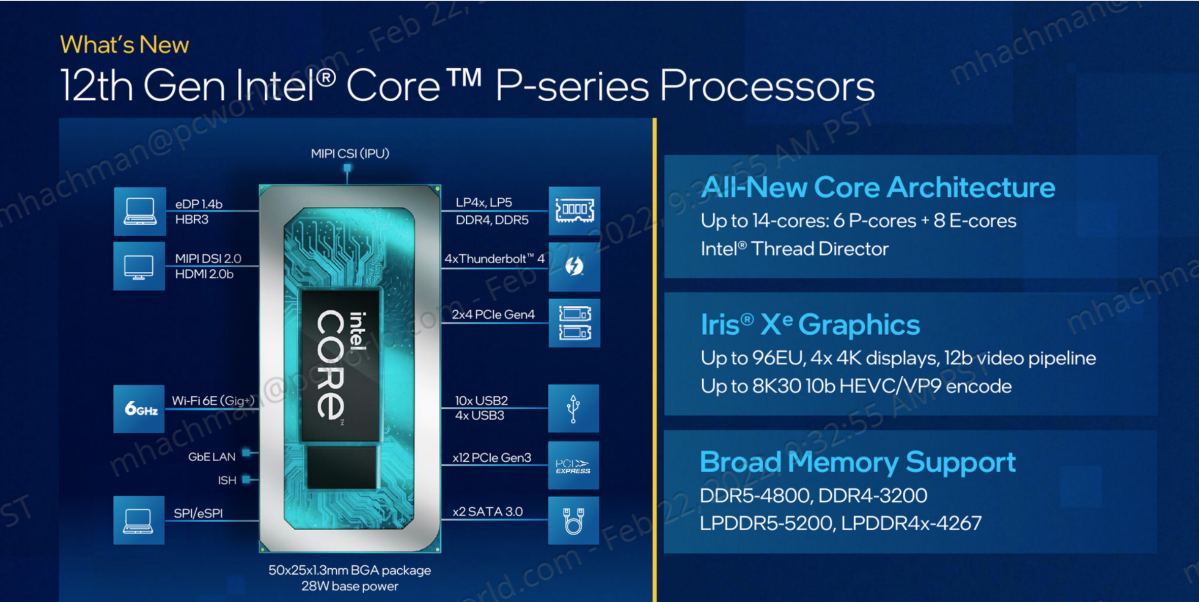
Intel
Intel
Intel
The new Alder Lake P-series does allow for the same variety of memory support also found inside both Intel’s desktop version of Alder Lake and its mobile H-series chips: DDR5-4800, DDR4-3200, LPDDR5-5200, and LPDDR4x-4267. That will allow for some flexibility if you need to upgrade your laptop.
12th-gen Alder lake desktop chips
Intel Core i5-12600K
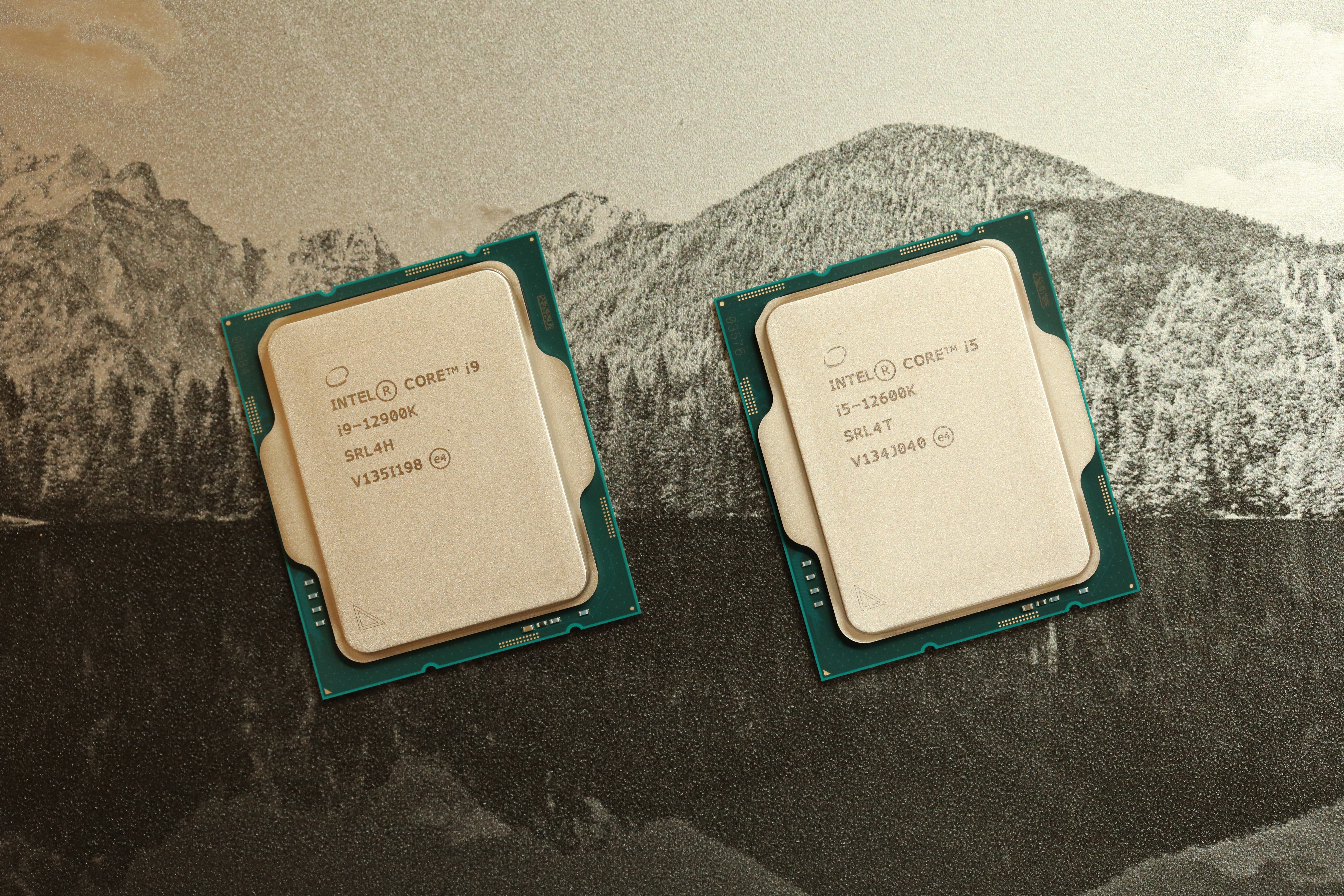 Price When Reviewed:$289Best Prices Today:$175.20 at Amazon | $184.99 at Walmart | $187.99 at B&H
Price When Reviewed:$289Best Prices Today:$175.20 at Amazon | $184.99 at Walmart | $187.99 at B&H
Intel is also offering an Intel imaging chip, the IMX488, that you may see in some laptops; Intel also refers to this as the Intel IPU 6.0. This probably won’t be highlighted on the list of specifications, though Intel is promising you’ll see better webcam performance as a result. (Intel is still recommending a 720p webcam as part of its premium Evo brand, because the size of the 1080p camera modules can be too large to fit inside some laptop bezels.) Intel is also including a new intelligent audio noise suppression capability, so that your roommate vacuuming in the background won’t break into your Zoom call.
From a performance standpoint, Intel is using the argument that it can’t make generation-to-generation comparisons, as there were no 11th-gen P-series chips to compare them to. Instead, Intel provided two sets of benchmarks, one covering common productivity applications and the other a more generic gaming roundup. Intel believes that you’ll be able to play many games using just the chip’s integrated graphics, though potentially at lower settings.
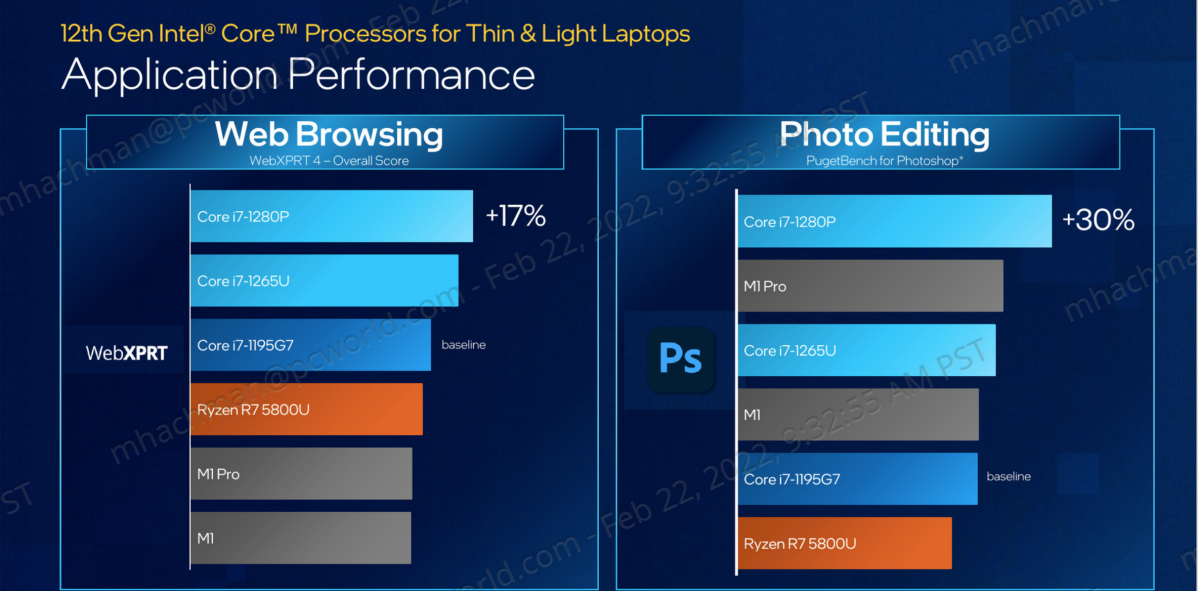
Intel
Intel
Intel
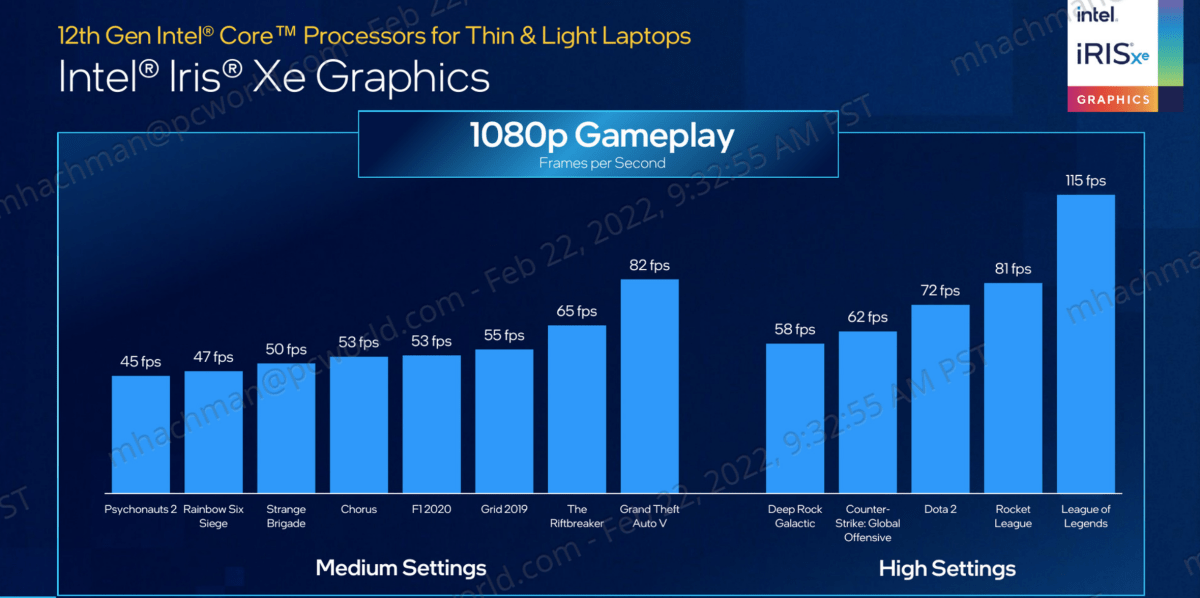
Intel
Intel
Intel
Intel’s U-Series: optimized for low power
Intel’s Alder Lake U-series chips are offered in one of two configurations: either 15 watts or 9 watts. At one time, Intel might have called these “Y”-series chips for ultralight laptops and Windows tablets. In any event, Microsoft will almost certainly offer them as options inside its Surface tablets, though whether they’ll reside within the main Surface Pro lineup or the smaller, cheaper Surface Go line remains to be seen. The 9W chips are also designed for upcoming foldable PCs, though that category has remained a bit of a white whale to date. Naturally, long battery life is more the focus here, rather than performance.
Designing the same processor for two different types of machines will affect performance, though the core counts will be the same across the U-series line: two performance cores, and between four and eight efficiency cores. If you opt for a thicker, more full-featured laptop with an Alder Lake-U series chip inside, you’ll be buying at least a Core i3 chip with a base P-core frequency of 1.2GHz, up to a turbo frequency of 4.8GHz. A U-series Core i7-1265U’s two performance cores will run at 1.8GHz at its base frequency and 4.8GHz while in turbo mode. The graphics capabilities will be about the same as the P-series chips in terms of EU count, though the clock speeds have been dialed down to conserve power.
Both the 15W and 9W configurations also include Pentium and Celeron options, shrinking down the core counts further to save cost at the expense of performance.
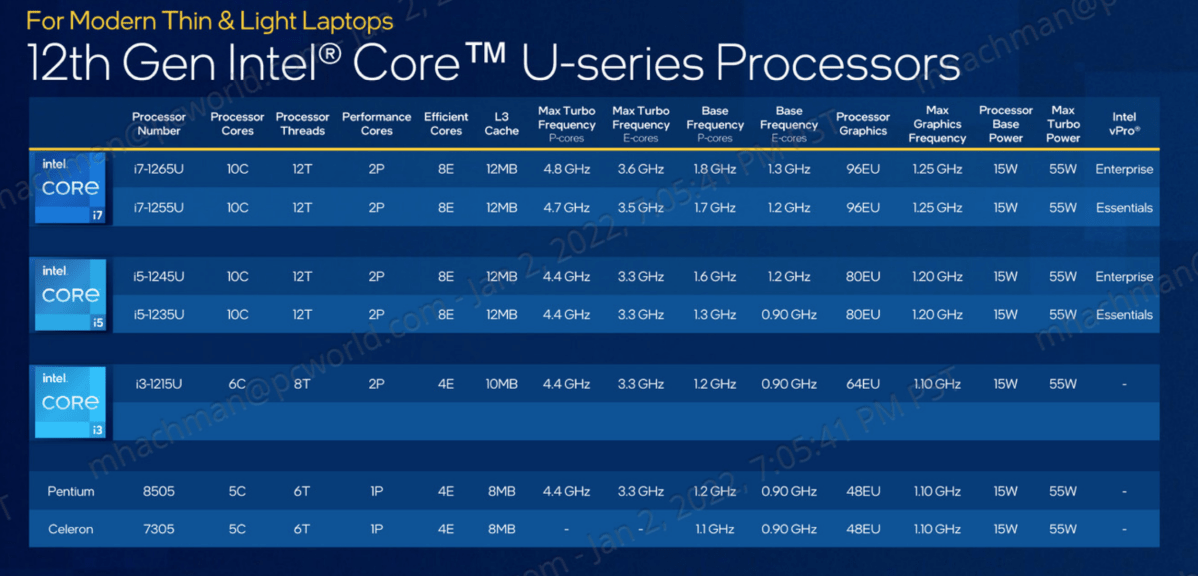
Intel
Intel
Intel
The lower-power 9W U-series chips dial down the core clocks dramatically, though the number of cores remains the same. Note how the Core i3 base frequency, at 1.0GHz, is lower than the 15W option; the Core i3 turbo clock for the performance core is still 4.4GHz. At the high end, the base P-core clock speed increases from 1.1GHz to a turbo speed of 4.7GHz.

Intel
Intel
Intel
We don’t have performance data for Intel’s new U-series chips…but consumers probably won’t be buying them for performance. The key metric, though, will be battery life — and we don’t know much about the actual numbers there, either.
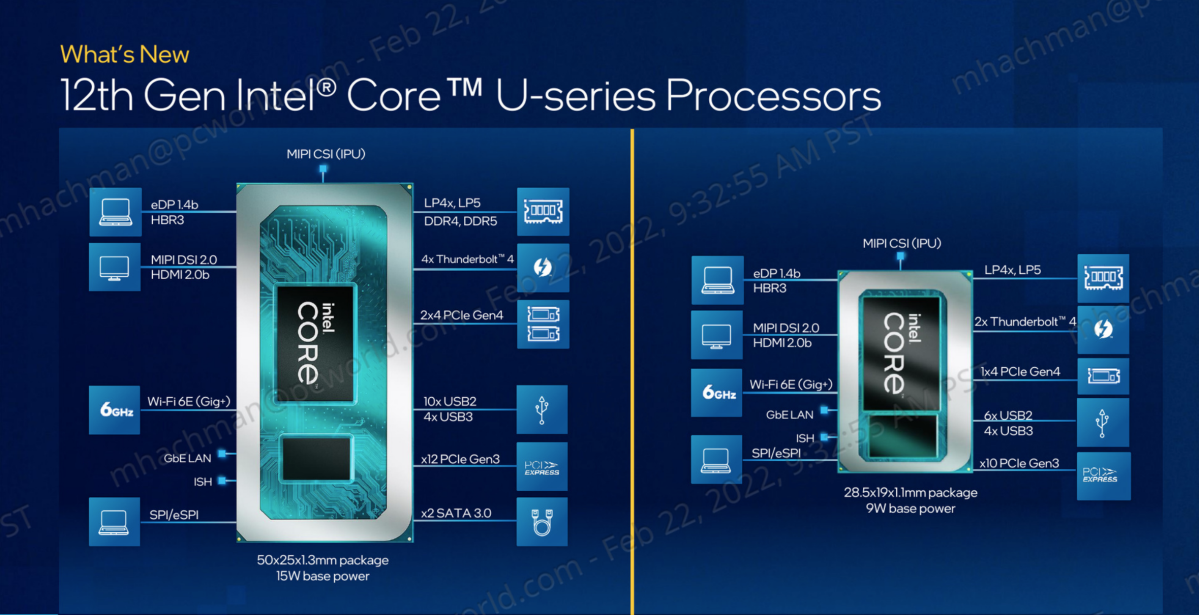
Intel
Intel
Intel
That shouldn’t matter, however. Now that Intel has officially launched both the Alder Lake U- and P-series, we should be seeing more and more notebook PCs with them inside, especially with Intel’s plans to expand its Evo premium notebook brand even further. (We’re hearing that reviews may begin in March.) We’ll have a good idea of how they shape up before long. Stay tuned to our roundup of the best laptops to see how Intel’s new chips shake out.
This story was updated at 10:25 AM with additional detail.
Author: Mark Hachman, Senior Editor

As PCWorld’s senior editor, Mark focuses on Microsoft news and chip technology, among other beats. He has formerly written for PCMag, BYTE, Slashdot, eWEEK, and ReadWrite.
Recent stories by Mark Hachman:
No, Intel isn’t recommending baseline power profiles to fix crashing CPUsApple claims its M4 chip’s AI will obliterate PCs. Nah, not reallyIntel says manufacturing problems are hindering hot Core Ultra sales




